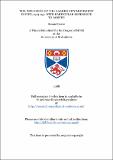Files in this item
The influence of the Garden City movement in Fife, 1914-23 : with particular reference to Rosyth
Item metadata
| dc.contributor.advisor | Frew, John (John M.) | |
| dc.contributor.author | Gleave, Susan | |
| dc.coverage.spatial | 265 p. | en_US |
| dc.date.accessioned | 2018-07-12T12:50:08Z | |
| dc.date.available | 2018-07-12T12:50:08Z | |
| dc.date.issued | 1988 | |
| dc.identifier.uri | https://hdl.handle.net/10023/15308 | |
| dc.description.abstract | This thesis is divided into sixteen chapters. Chapter 1 deals with the origins and development of the Garden City Movement, detailing Howard's original vision of a Garden City, the consequent popularising of his theories and the formation of the Garden City Association; also the large amount of literature published during the early 20th century on housing design, and the theories of Raymond Unwin. The chapter concludes by identifying signs of reaction again.st "Garden City" values, occurring slightly before the outbreak of the First World War. Chapters 2 to 9 detail the development of the Garden City at Rosyth, created for the Admiralty employees at the new Naval Base around 1915. The Garden City Association's enthusiastic anticipation of a model town, their subsequent disillusion due to the long delays in negotiations between the Admiralty and the Local Government Board for Scotland are documented In detail and followed by an account of the building operations by the Scottish National Housing Company Ltd., and further negotiations regarding the housing at Rosyth. Chapter 10 deals with the legislation and the designs for state-aided housing at the end of the First World War. The findings of the Royal Commission on housing in Scotland, of 1917, and the recommendations of numerous Government Committees concerning the provision of such housing are detailed, and followed by a summary of legislation passed oil this subject between 1919 and 1923. Chapters 11 to 15 focus on the post-war housing schemes at Dunfermline, Inverkeithing, Kirkcaldy, Buckhaven and Methil, and Leven. Chapter 16 provides a final and concluding assessment of the impact of the Garden City Movement, first of all at Rosyth, and then in the above post-war housing schemes. The difficulties of putting; Garden City ideals into practice are discussed, and the economic and theoretical reasons for the reduction of many of the schemes, and the growing tendency towards standardisation, are identified. | en_US |
| dc.language.iso | en | en_US |
| dc.publisher | University of St Andrews | |
| dc.subject.lcc | NA9190.F5G6 | en |
| dc.subject.lcsh | City planning--Scotland | en |
| dc.title | The influence of the Garden City movement in Fife, 1914-23 : with particular reference to Rosyth | en_US |
| dc.type | Thesis | en_US |
| dc.type.qualificationlevel | Masters | en_US |
| dc.type.qualificationname | MPhil Master of Philosophy | en_US |
| dc.publisher.institution | The University of St Andrews | en_US |
This item appears in the following Collection(s)
Items in the St Andrews Research Repository are protected by copyright, with all rights reserved, unless otherwise indicated.

